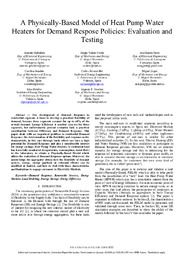Por favor, use este identificador para citar o enlazar este ítem:
https://hdl.handle.net/11000/30987Registro completo de metadatos
| Campo DC | Valor | Lengua/Idioma |
|---|---|---|
| dc.contributor.author | Gabaldón, Antonio | - |
| dc.contributor.author | VALERO, SERGIO | - |
| dc.contributor.author | García-Garre, Ana | - |
| dc.contributor.author | Senabre, Carolina | - |
| dc.contributor.author | Álvarez-Bel, Carlos | - |
| dc.contributor.author | López, Miguel | - |
| dc.contributor.author | Peñalvo, Elisa | - |
| dc.contributor.author | Sánchez, Eugenio P. | - |
| dc.contributor.other | Departamentos de la UMH::Ingeniería Mecánica y Energía | es_ES |
| dc.date.accessioned | 2024-02-02T17:28:36Z | - |
| dc.date.available | 2024-02-02T17:28:36Z | - |
| dc.date.created | 2018-09-10 | - |
| dc.identifier.uri | https://hdl.handle.net/11000/30987 | - |
| dc.description.abstract | The development of Demand Response in residential segments is basic to develop a practical flexibility of demand, because these segments account for up to 40% of the overall demand. Energy Efficiency is another concern for these segments, but unfortunately present scenarios lack a practical coordination between Efficiency and Demand Response. This paper deals with an important problem in residential Demand Response: the determination of the flexibility and response on the demand-side, in this case through loads which can have a high potential for Demand Response and also a considerable interest for energy savings: Heat Pump Water Heaters. A residential load has been fully monitored (temperature, consumption, water flow) in the laboratory to obtain a Physically-Based Model which allows the evaluation of Demand Response options. Moreover, the model helps the aggregator obtain how the flexibility of demand (power, energy, energy payback or rebound effects) can be modified or limited, and how to deal with these characteristics and limitations to engage customers in Electricity Markets. | es_ES |
| dc.format | application/pdf | es_ES |
| dc.format.extent | 6 | es_ES |
| dc.language.iso | eng | es_ES |
| dc.publisher | Institute of Electrical and Electronics Engineers | es_ES |
| dc.relation.ispartof | 2018 International Conference on Smart Energy Systems and Technologies (SEST) | es_ES |
| dc.rights | info:eu-repo/semantics/openAccess | es_ES |
| dc.rights | Attribution-NonCommercial-NoDerivatives 4.0 Internacional | * |
| dc.rights.uri | http://creativecommons.org/licenses/by-nc-nd/4.0/ | * |
| dc.subject | demand response | es_ES |
| dc.subject | renewable sources | es_ES |
| dc.subject | energy markets | es_ES |
| dc.subject | load modeling | es_ES |
| dc.subject | energy storage | es_ES |
| dc.subject | energy efficieny | es_ES |
| dc.subject.classification | Ingeniería eléctrica | es_ES |
| dc.subject.other | CDU::6 - Ciencias aplicadas::62 - Ingeniería. Tecnología | es_ES |
| dc.title | A Physically-Based Model of Heat Pump Water Heaters for Demand Respose Policies: Evaluation and Testing | es_ES |
| dc.type | info:eu-repo/semantics/other | es_ES |
| dc.relation.publisherversion | http://dx.doi.org/10.1109/SEST.2018.8495703 | es_ES |

Ver/Abrir:
Paper 2 Congreso -- A_Physically-Based_Model_of_Heat_Pump_Water_Heaters_for_Demand_Respose_Policies_Evaluation_and_Testing.pdf
1,14 MB
Adobe PDF
Compartir:
 La licencia se describe como: Atribución-NonComercial-NoDerivada 4.0 Internacional.
La licencia se describe como: Atribución-NonComercial-NoDerivada 4.0 Internacional.
.png)